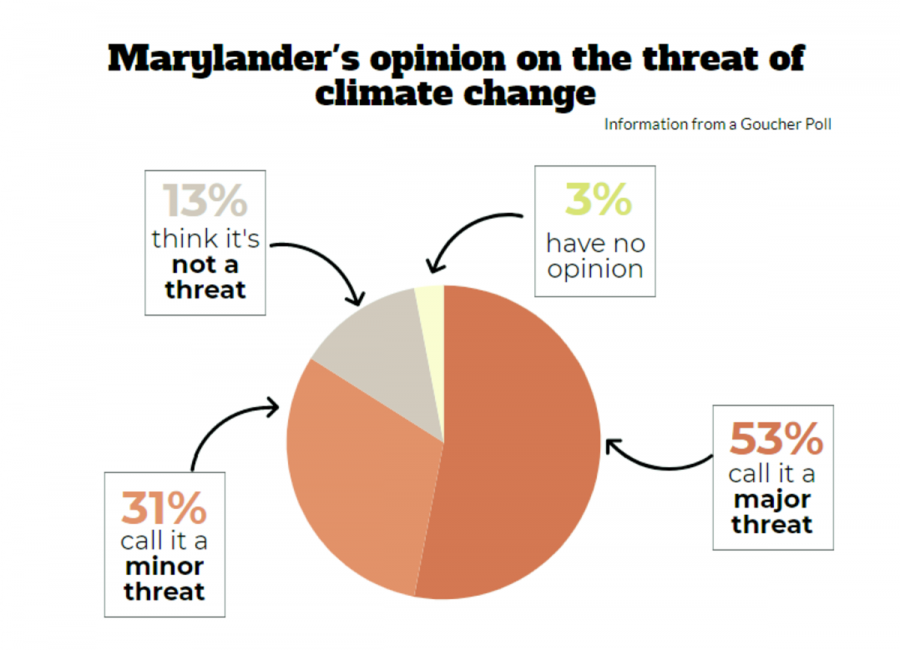Renew the fight for renewable energy
April 26, 2018
If President Trump has been consistent in anything, it’s his environmental policy. From pulling out of the Paris Climate Accords to removing climate considerations from infrastructure projects, he’s been nothing but steady in his nationwide scale-back of environmental protection.
While Trump has some national support for a de-emphasis on environmental policy, however, he doesn’t get a lot of it from Maryland: 84 percent of Marylanders think climate change poses a threat to the well-being of Maryland residents, according to a 2014 Goucher poll. If the national government won’t take action, our state government should. There’s one very effective way to do this: the Maryland General Assembly should reintroduce The 100 Percent Clean Renewable Energy and Equity Act, Bill HB878.
The bill was withdrawn on March 15 after an unfavorable review by the House Committee of Economic Matters, but its measures are promising. It builds a sustainable pathway for us as a state to use only clean renewable energy by 2035. The bill presents a two-pronged solution: it puts an end to counterproductive “renewable” energy sources that actually end up polluting the environment, and at the same time, it incentivizes wind and solar electricity generation.
First and foremost, the bill ends subsidies for polluting sources of electricity. Maryland taxpayers currently subsidize $46 million worth of greenhouse-gas emitting sources of electricity, like trash incineration and burning trees, according to the Board of Directors of Chesapeake Physicians for Social Responsibility. These methods are technically considered renewable, but they’re more harmful to the environment than helpful—in fact, trash incineration releases more carbon dioxide per unit of electricity than coal-fired power plants, reports the National Toxics Network.
Second, the bill incentivizes electricity companies to invest in both solar and wind energy. For solar, it provides rebates—a cash incentive—for in-state solar installation. The rebate gradually declines the longer the bill is around, which spurs quick investment into the beneficial source. For wind, the bill creates a new program that requires utilities to enter long-term contracts with offshore wind providers in Maryland.
Renewable energy resources currently account for only 7.2 percent of Maryland’s total net electricity generation, according to the U.S. Energy Information Administration. But making the switch to more renewables could make a meaningful impact in reducing CO2 emissions—it would prevent production of almost 240 million metric tons of CO2, the equivalent of taking almost 3 million cars off the road, according to the Sierra Club. As a result, we would save almost $10 billion in the “social costs” of carbon—things like health bills and destruction of property.
The bill’s benefits aren’t only in the environmental sector; it also boosts the economy. Development of an offshore wind industry and expanding the solar industry in Maryland would create thousands of jobs. In fact, when testifying on behalf of the bill, the Sierra Club estimated that the bill would directly create 12,000 jobs in the renewable energy sector.
The benefits are even bigger in the long-term. Since the costs of renewable energy fall mostly in short term installation costs, requiring only minor maintenance in the long term, we actually end up saving money on electricity. In fact, non-profit organization Food and Water Watch estimates that the bill would save Maryland $5.5 billion per year in energy expenditures by 2050.
The House Committee of Economic Matters voiced a credible concern that switching to renewable energy would pass large costs on to consumers. However, because costs would be spread out, they wouldn’t affect anyone too adversely; the average household cost would be $1.50/month between 2019 and 2035, according to legislative economic analysis. And the most at-risk would be protected: the bill caps low-income households’ electricity costs at six percent of income.
The Trump administration may be playing down the importance of climate change, but for a state with 3,000 miles of coastline, we can’t afford to forget the importance of environmental protection. The 100 Percent Bill is the best way to keep both the environment and the economy thriving in Maryland.









Concerned • Apr 27, 2018 at 1:04 pm
I strongly agree with this article…Keep up the great work!